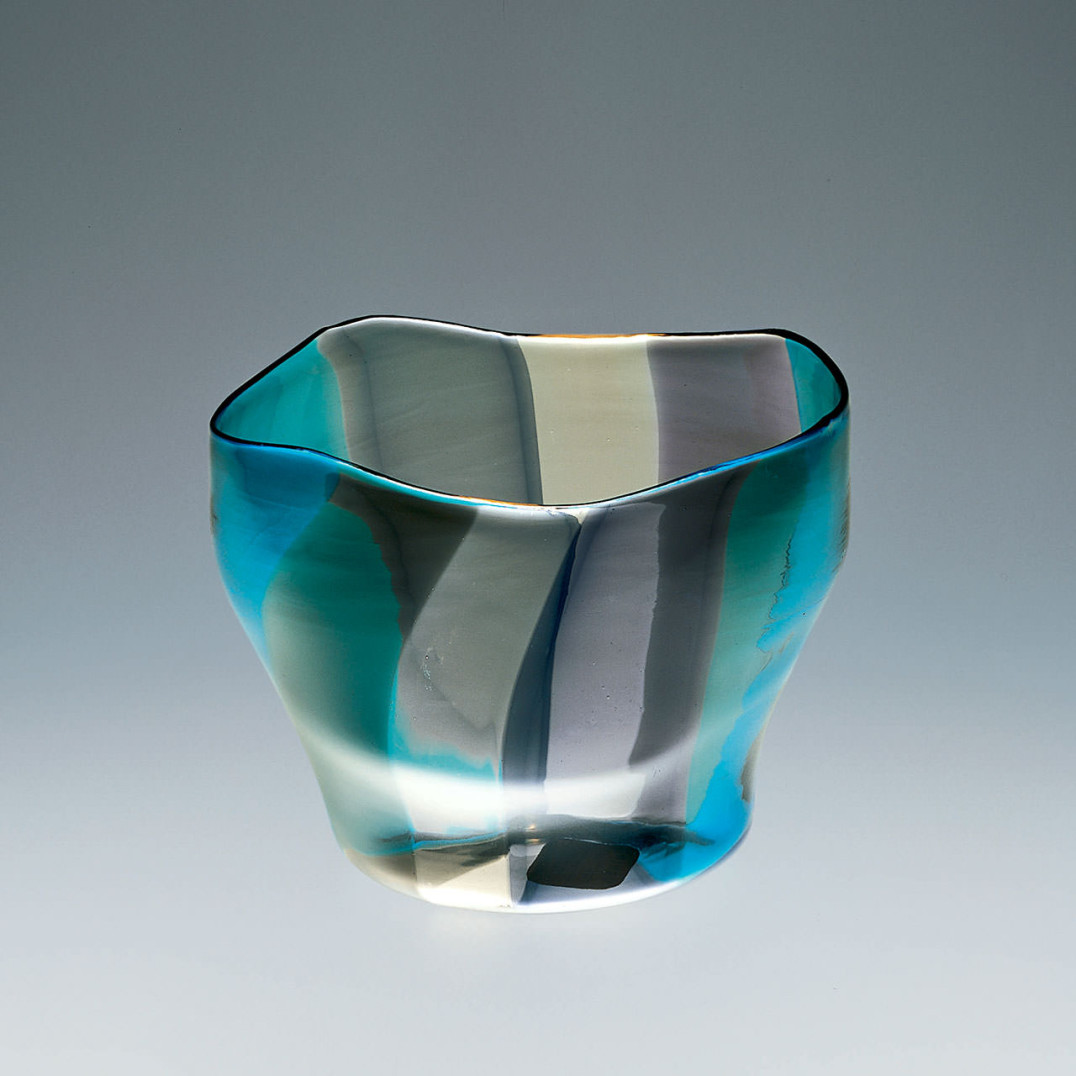
Fulvio BianconiA spicchi, 1951
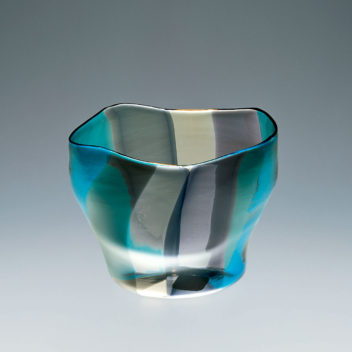
Fulvio BianconiA spicchiVenini & C., 1951
Bowl in glass with turquoise, amethyst, gray, and clear cristallo spicchi (sections).
Original paper label.
5 1/2 in. high (14 cm)
Exhibitions:
1951, Milan, 9th Triennale;
1952, Venice, 26th Biennale Internazionale d’Arte;
2001, Milan, Murano: Vetri dalla Collezione Olnick Spanu, Spazio Oberdan.
Bibliography and comparative texts:
Venini, grey catalogue, nn. 4896;
Vetri. Quaderni…, 1951, p. 84;
Domus, 1959, December, p. 42;
Venini & Murano…, n. 57;
W. Neuwirth, 1987, n. 182;
M. Heiremans, 1989, n. 227;
R. Bossaglia, 1993, n. 32;
M. Barovier, 1994, n. 23;
A. Venini Diaz de Santillana, 1996, n. 119;
M. Heiremans, 1996, n. 110;
A. Venini Diaz de Santillana, 1999, n. 162;
Olnick Spanu, 2001, n. 120.
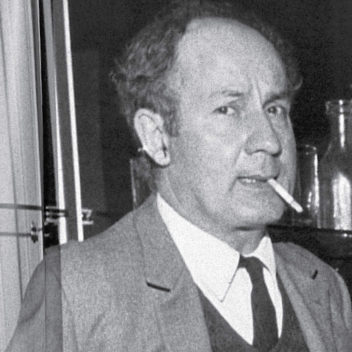
Fulvio Bianconi 1915–1996
Fulvio Bianconi was a graphic artist, caricaturist, and designer. Born in Padua, he attended the Istituto d'Arte and the Accademia di Belle Arti in Venice. He first encountered glass at age fifteen when he studied decoration with enamels under the guidance of Michele Pinto. During the late '30s, he worked as a caricaturist, graphic artist, and illustrator for various publishing houses such as Mondadori, Rizzoli, Garzanti, and others. After World War II, he came to Murano to study glass techniques and met Paolo Venini. A productive relationship ensued as he began a collaboration with Venini in 1947 that lasted through the entire decade of the '50s. One of his most characteristic works is the long series of stylized figurines which Bianconi designed at the end of the '40s, taking his inspiration from the Italian Commedia dell'Arte. His pezzati vessels proved extraordinary due to their richness in color, as were the fazzoletti, presented in several different vitreous textures, which he created with Venini himself. He obtained widespread acclaim for the a Macchie and Fasce orrizontali series, in which Bianconi revealed a marked painterly vocation. In the '50s, he worked with other workshops such as the Vetreria Cenedese, designing vessels with applications and other pieces with cased decorations. From 1958 to 1961, he designed glass pieces for I.V.R. Mazzega. In 1963, he designed for the Vetreria Vistosi. And in 1967, he began working again with Venini, creating vessels with unusual shapes such as the Informale (1968). After another contact with Venini in 1989, he designed for De Majo from 1991 to 1992.

Venini & C. 1932–2001
In 1932, when both Martinuzzi and Zecchin left the company, Paolo Venini changed the name from Vetri Soffiati Muranesi Venini & Co. (V.S.M. Venini & Co.) to Venini & C.. Milanese architect Tommaso Buzzi became the new artistic director. After 1934, artistic direction was taken on by Carlo Scarpa, who designed most of the company's production through 1947. Side by side with Venini, who often intervened personally in design, Scarpa created numerous collections of objects characterized by refined colors. After World War II, Venini & C. sought numerous collaborations with artists such as architect Giò Ponti and the Swedish-born Tyra Lundgren. After 1948, Fulvio Bianconi, Massimo Vignelli, and Tobia Scarpa contributed significantly to the new direction of the company. Paolo Venini died in 1959 and his son-in-law, Ludovico Diaz de Santillana, took over the management of Venini & C. He not only worked personally as a glass designer but also continued the collaboration started by Paolo Venini with various artists and designers. Starting in 1960, many other designers collaborated with the company, like Thomas Stearns, Toni Zuccheri, Tapio Wirkkala, Laura and Alessandro Diaz de Santillana, James Carpenter, Dan Dailey, Richard Marquis, Benjamin Moore, and Toots Zynsky. In 1986, the de Santillana family left the company, selling their stock to the Ferruzzi group, which guaranteed the fine quality Venini was known for by hiring new designers such as Timo Sarpaneva, Marco Zanini, Ettore Sottsass Jr., Alessandro Mendini, Mario Bellini, Barbara del Vicario, and others. In 1988, Venini was acquired by Royal Scandinavian. Since 2001, Venini S.p.A. has been part of Italian Luxury Industries Group and is led by Giancarlo Chimento, Giuliano Tabacchi, and Giorgio Rizzo.
Fulvio BianconiA spicchi, 1951
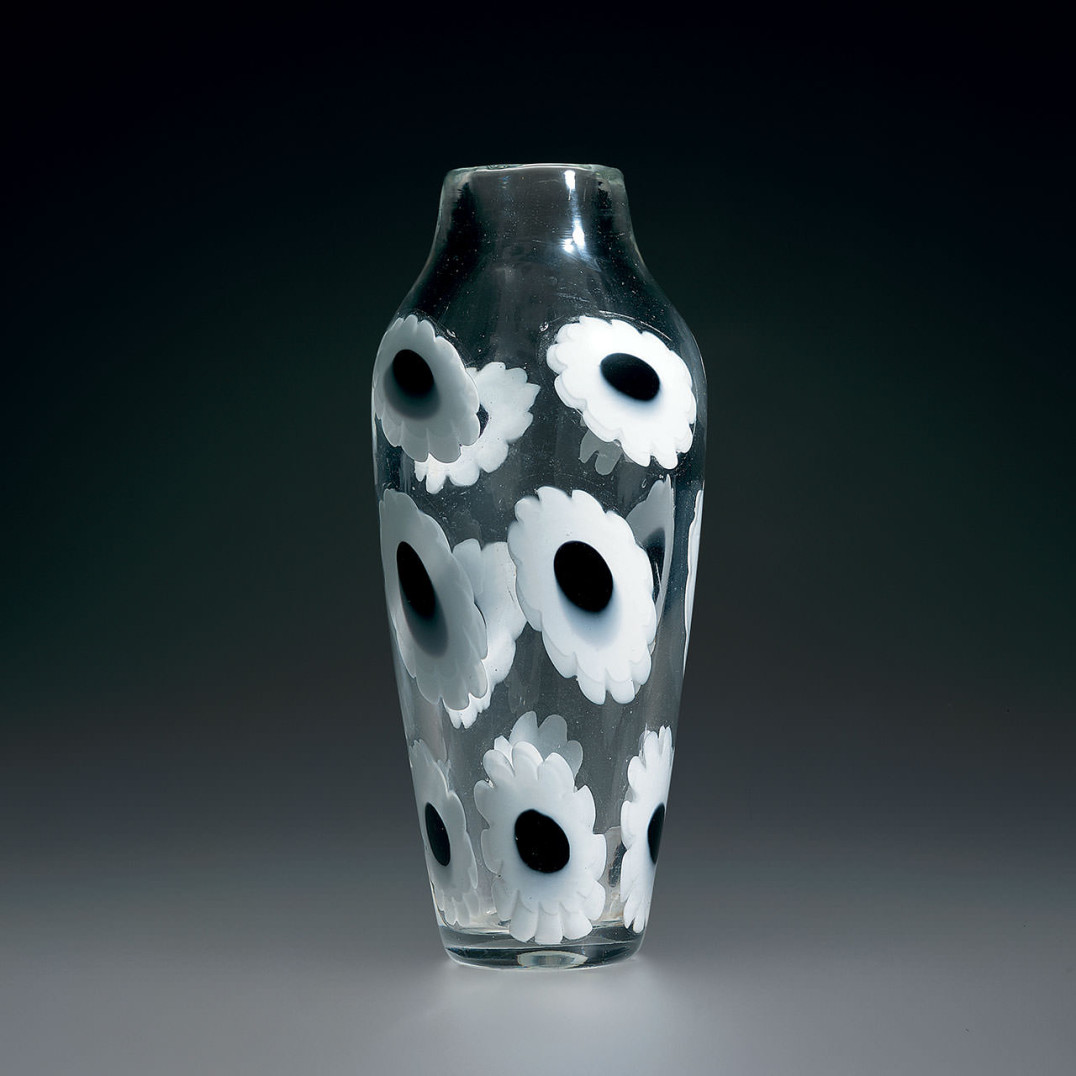
Fulvio BianconiMargherite, 1950
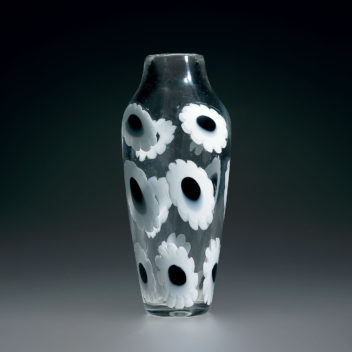
Fulvio BianconiMargheriteVenini & C., 1950
Vase in thick clear cristallo glass decorated with a daisy motif murrine of lattimo and amethyst glass. The vase is part of a very limited series commissioned by a client in Paris in the 1950s.
Acid stamped:
venini murano ITALIA.
13 5/8 in. high (34.6 cm)
Exhibitions:
1951, Milan, 9th Triennale;
1952, Venice, 26th Biennale Internazionale d’Arte;
2001, Milan, Murano: Vetri dalla Collezione Olnick Spanu, Spazio Oberdan.
Bibliography and comparative texts:
Vetri. Quaderni….1951, p. 88;
M. Heiremans, 1989, n. 190;
M. Heiremans, 1993, n. 216;
Olnick Spanu, 2001, n. 119.

Fulvio Bianconi 1915–1996
Fulvio Bianconi was a graphic artist, caricaturist, and designer. Born in Padua, he attended the Istituto d'Arte and the Accademia di Belle Arti in Venice. He first encountered glass at age fifteen when he studied decoration with enamels under the guidance of Michele Pinto. During the late '30s, he worked as a caricaturist, graphic artist, and illustrator for various publishing houses such as Mondadori, Rizzoli, Garzanti, and others. After World War II, he came to Murano to study glass techniques and met Paolo Venini. A productive relationship ensued as he began a collaboration with Venini in 1947 that lasted through the entire decade of the '50s. One of his most characteristic works is the long series of stylized figurines which Bianconi designed at the end of the '40s, taking his inspiration from the Italian Commedia dell'Arte. His pezzati vessels proved extraordinary due to their richness in color, as were the fazzoletti, presented in several different vitreous textures, which he created with Venini himself. He obtained widespread acclaim for the a Macchie and Fasce orrizontali series, in which Bianconi revealed a marked painterly vocation. In the '50s, he worked with other workshops such as the Vetreria Cenedese, designing vessels with applications and other pieces with cased decorations. From 1958 to 1961, he designed glass pieces for I.V.R. Mazzega. In 1963, he designed for the Vetreria Vistosi. And in 1967, he began working again with Venini, creating vessels with unusual shapes such as the Informale (1968). After another contact with Venini in 1989, he designed for De Majo from 1991 to 1992.

Venini & C. 1932–2001
In 1932, when both Martinuzzi and Zecchin left the company, Paolo Venini changed the name from Vetri Soffiati Muranesi Venini & Co. (V.S.M. Venini & Co.) to Venini & C.. Milanese architect Tommaso Buzzi became the new artistic director. After 1934, artistic direction was taken on by Carlo Scarpa, who designed most of the company's production through 1947. Side by side with Venini, who often intervened personally in design, Scarpa created numerous collections of objects characterized by refined colors. After World War II, Venini & C. sought numerous collaborations with artists such as architect Giò Ponti and the Swedish-born Tyra Lundgren. After 1948, Fulvio Bianconi, Massimo Vignelli, and Tobia Scarpa contributed significantly to the new direction of the company. Paolo Venini died in 1959 and his son-in-law, Ludovico Diaz de Santillana, took over the management of Venini & C. He not only worked personally as a glass designer but also continued the collaboration started by Paolo Venini with various artists and designers. Starting in 1960, many other designers collaborated with the company, like Thomas Stearns, Toni Zuccheri, Tapio Wirkkala, Laura and Alessandro Diaz de Santillana, James Carpenter, Dan Dailey, Richard Marquis, Benjamin Moore, and Toots Zynsky. In 1986, the de Santillana family left the company, selling their stock to the Ferruzzi group, which guaranteed the fine quality Venini was known for by hiring new designers such as Timo Sarpaneva, Marco Zanini, Ettore Sottsass Jr., Alessandro Mendini, Mario Bellini, Barbara del Vicario, and others. In 1988, Venini was acquired by Royal Scandinavian. Since 2001, Venini S.p.A. has been part of Italian Luxury Industries Group and is led by Giancarlo Chimento, Giuliano Tabacchi, and Giorgio Rizzo.
Fulvio BianconiMargherite, 1950
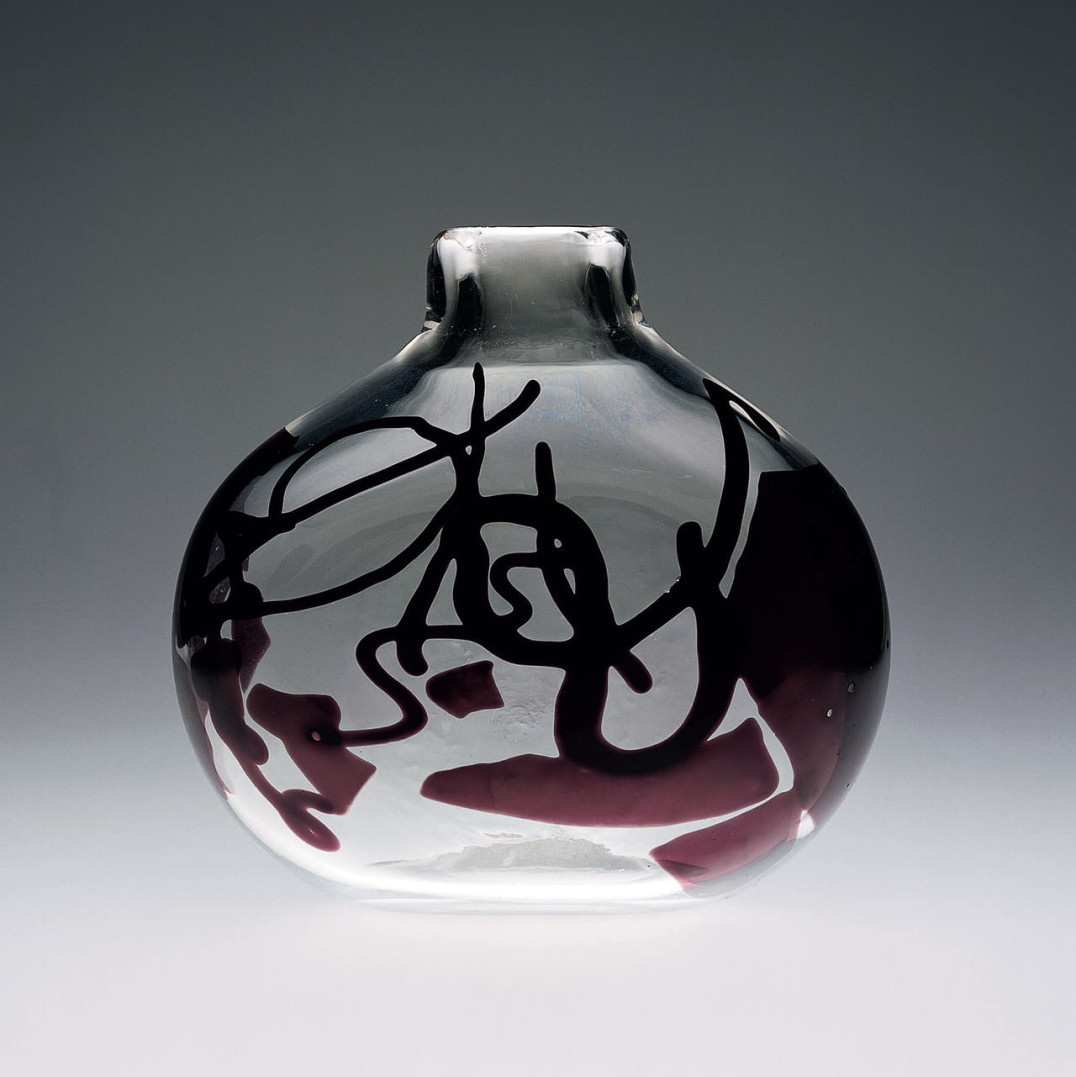
Fulvio BianconiA macchie, 1950
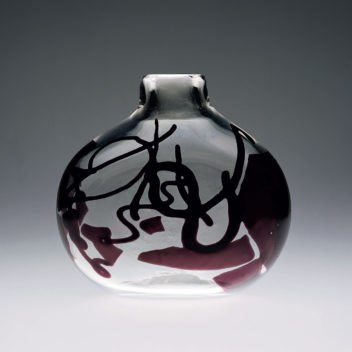
Fulvio BianconiA macchieVenini & C., 1950
Vase composed of cristallo glass decorated with an abstract pattern obtained by the inclusion of aubergine macchie (stains) of glass.
Acid stamped:
venini murano ITALIA.
9 7/8 in. high (25.1 cm)
Exhibitions:
1950, Venice, 25th Biennale Internazionale d’Arte;
1951, Milan, 9th Triennale;
1952, Venice, 26th Biennale Internazionale d’Arte;
2000, New York, Venetian Glass, Museum of Arts & Design;
2001, Milan, Murano: Vetri dalla Collezione Olnick Spanu, Spazio Oberdan.
Bibliography and comparative texts:
Venini, grey catalogue, n. 4324;
A. Gasparetto, 1960, n. 37;
F. Deboni, 1989, n. 116;
G. Duplani Tucci, 1989, n. 36;
M. Heiremans, 1993, n. 218;
R. Bossaglia, 1993, n. 34;
M. Barovier, R. Barovier Mentasti,
A. Dorigato, 1995, n. 83;
F. Deboni, 1996, p. 74, n. 212;
M. Heiremans, 1996, n. 89;
H. Ricke, E. Schmitt, 1996, nn. 73, 74;
Venini Venezia, 1998, p. 71;
M. Barovier, 1999, p. 227;
Olnick Spanu, 2000, n. 83;
R. Reif, New York Times, 2000, p. 39;
Olnick Spanu, 2001, n. 118.

Fulvio Bianconi 1915–1996
Fulvio Bianconi was a graphic artist, caricaturist, and designer. Born in Padua, he attended the Istituto d'Arte and the Accademia di Belle Arti in Venice. He first encountered glass at age fifteen when he studied decoration with enamels under the guidance of Michele Pinto. During the late '30s, he worked as a caricaturist, graphic artist, and illustrator for various publishing houses such as Mondadori, Rizzoli, Garzanti, and others. After World War II, he came to Murano to study glass techniques and met Paolo Venini. A productive relationship ensued as he began a collaboration with Venini in 1947 that lasted through the entire decade of the '50s. One of his most characteristic works is the long series of stylized figurines which Bianconi designed at the end of the '40s, taking his inspiration from the Italian Commedia dell'Arte. His pezzati vessels proved extraordinary due to their richness in color, as were the fazzoletti, presented in several different vitreous textures, which he created with Venini himself. He obtained widespread acclaim for the a Macchie and Fasce orrizontali series, in which Bianconi revealed a marked painterly vocation. In the '50s, he worked with other workshops such as the Vetreria Cenedese, designing vessels with applications and other pieces with cased decorations. From 1958 to 1961, he designed glass pieces for I.V.R. Mazzega. In 1963, he designed for the Vetreria Vistosi. And in 1967, he began working again with Venini, creating vessels with unusual shapes such as the Informale (1968). After another contact with Venini in 1989, he designed for De Majo from 1991 to 1992.

Venini & C. 1932–2001
In 1932, when both Martinuzzi and Zecchin left the company, Paolo Venini changed the name from Vetri Soffiati Muranesi Venini & Co. (V.S.M. Venini & Co.) to Venini & C.. Milanese architect Tommaso Buzzi became the new artistic director. After 1934, artistic direction was taken on by Carlo Scarpa, who designed most of the company's production through 1947. Side by side with Venini, who often intervened personally in design, Scarpa created numerous collections of objects characterized by refined colors. After World War II, Venini & C. sought numerous collaborations with artists such as architect Giò Ponti and the Swedish-born Tyra Lundgren. After 1948, Fulvio Bianconi, Massimo Vignelli, and Tobia Scarpa contributed significantly to the new direction of the company. Paolo Venini died in 1959 and his son-in-law, Ludovico Diaz de Santillana, took over the management of Venini & C. He not only worked personally as a glass designer but also continued the collaboration started by Paolo Venini with various artists and designers. Starting in 1960, many other designers collaborated with the company, like Thomas Stearns, Toni Zuccheri, Tapio Wirkkala, Laura and Alessandro Diaz de Santillana, James Carpenter, Dan Dailey, Richard Marquis, Benjamin Moore, and Toots Zynsky. In 1986, the de Santillana family left the company, selling their stock to the Ferruzzi group, which guaranteed the fine quality Venini was known for by hiring new designers such as Timo Sarpaneva, Marco Zanini, Ettore Sottsass Jr., Alessandro Mendini, Mario Bellini, Barbara del Vicario, and others. In 1988, Venini was acquired by Royal Scandinavian. Since 2001, Venini S.p.A. has been part of Italian Luxury Industries Group and is led by Giancarlo Chimento, Giuliano Tabacchi, and Giorgio Rizzo.
Fulvio BianconiA macchie, 1950
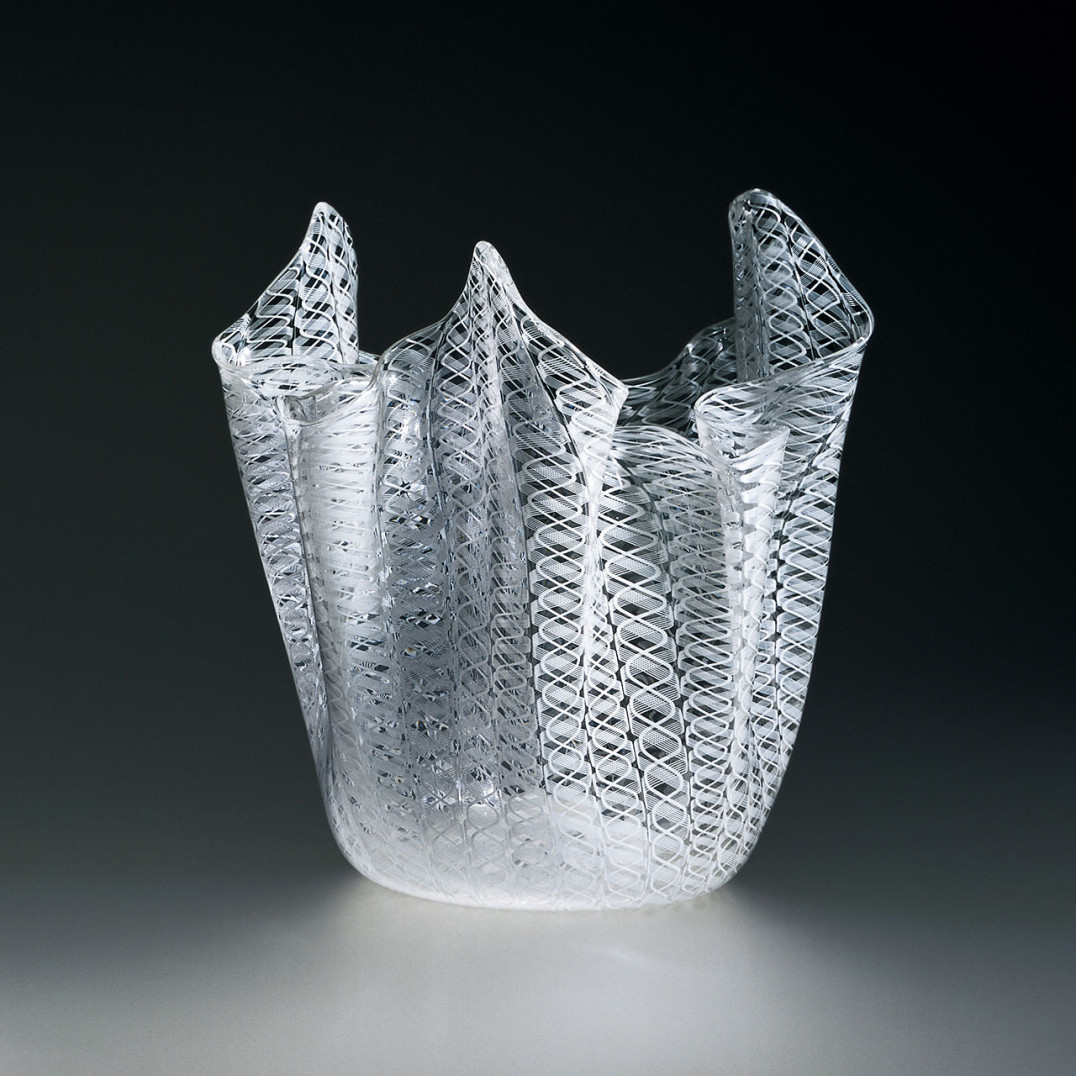
Fulvio BianconiPaolo VeniniFazzoletto, ca. 1950
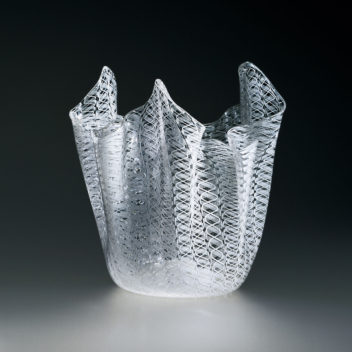
Fulvio BianconiPaolo VeniniFazzolettoVenini & C., ca. 1950
A handkerchief shaped vessel crafted with zanfirico lattimo canes of glass.
Acid stamped:
venini murano ITALIA.
11 1/4 in. high (28.6 cm)
Exhibitions:
1952, Venice, 26th Biennale Internazionale d’Arte;
2000, New York, Venetian Glass, Museum of Arts & Design;
2001, Milan, Murano: Vetri dalla Collezione Olnick Spanu, Spazio Oberdan.
Bibliography and comparative texts:
Venini, grey catalogue, n. 2986;
Domus, October, 1951, p. 29;
R. Aloi, 1952, n. 29;
G. Ponti, 1959, p. 38;
Mille anni…, 1982, n. 649;
R. Barovier Mentasti, 1982, n. 323;
W. Neuwirth, 1987, n. 75;
R. Bossaglia, 1993, nn. 17, 20;
M. Barovier, 1994, nn. 14, 15;
F. Deboni, 1996, nn. 206, 207;
A. Venini Diaz de Santillana, 1996, nn. 130, 132;
M. Heiremans, 1996, n. 84;
H. Ricke, E. Schmitt, 1996, n. 69;
M. Barovier, 1998 (b), p. 231;
Venini Venezia, 1998, p. 68;
M. Barovier, 1999, p. 231;
Olnick Spanu, 2000, n. 82;
Olnick Spanu, 2001, n. 117.

Fulvio Bianconi 1915–1996
Fulvio Bianconi was a graphic artist, caricaturist, and designer. Born in Padua, he attended the Istituto d'Arte and the Accademia di Belle Arti in Venice. He first encountered glass at age fifteen when he studied decoration with enamels under the guidance of Michele Pinto. During the late '30s, he worked as a caricaturist, graphic artist, and illustrator for various publishing houses such as Mondadori, Rizzoli, Garzanti, and others. After World War II, he came to Murano to study glass techniques and met Paolo Venini. A productive relationship ensued as he began a collaboration with Venini in 1947 that lasted through the entire decade of the '50s. One of his most characteristic works is the long series of stylized figurines which Bianconi designed at the end of the '40s, taking his inspiration from the Italian Commedia dell'Arte. His pezzati vessels proved extraordinary due to their richness in color, as were the fazzoletti, presented in several different vitreous textures, which he created with Venini himself. He obtained widespread acclaim for the a Macchie and Fasce orrizontali series, in which Bianconi revealed a marked painterly vocation. In the '50s, he worked with other workshops such as the Vetreria Cenedese, designing vessels with applications and other pieces with cased decorations. From 1958 to 1961, he designed glass pieces for I.V.R. Mazzega. In 1963, he designed for the Vetreria Vistosi. And in 1967, he began working again with Venini, creating vessels with unusual shapes such as the Informale (1968). After another contact with Venini in 1989, he designed for De Majo from 1991 to 1992.
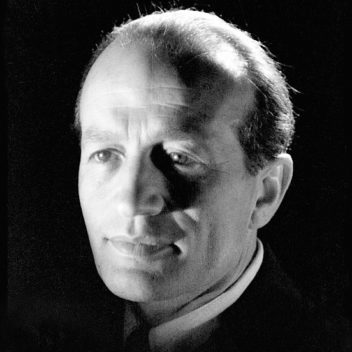
Paolo Venini 1895–1959
Born in Milan, the entrepreneur and designer Paolo Venini was a law school graduate. From 1921 until he died, he dedicated himself to the workshop he founded, the Vetri Soffiati Muranesi Venini & C. (through 1925, Vetri Soffiati Muranesi Cappellin Venini & C.). A man of marked entrepreneurial talent, his goal from the very beginning was to expand his company's influence abroad and he sought the collaboration of the most talented artists and architects of his time, employing them as artistic directors of his company. He always worked at the side of his designers with the goal of anticipating and directing taste. He personally checked every collection produced by his furnace. And his confident aesthetic choices, along with the fine quality of the products, assured his workshop both critical and commercial success. He dedicated himself personally to design from the '30s: his Diamante glass pieces date from 1936, and he created the murrine romane in collaboration with Carlo Scarpa. Following the war, he created bottles with brightly colored stripes, vessels in mosaico zanfirico and mosaico tessuto, glass mosaic windows, and engraved vessels. In collaboration with Bianconi, he created vessels such as the fazzoletti, which are a classic example of the production of the '50s, and were enormously successful.

Venini & C. 1932–2001
In 1932, when both Martinuzzi and Zecchin left the company, Paolo Venini changed the name from Vetri Soffiati Muranesi Venini & Co. (V.S.M. Venini & Co.) to Venini & C.. Milanese architect Tommaso Buzzi became the new artistic director. After 1934, artistic direction was taken on by Carlo Scarpa, who designed most of the company's production through 1947. Side by side with Venini, who often intervened personally in design, Scarpa created numerous collections of objects characterized by refined colors. After World War II, Venini & C. sought numerous collaborations with artists such as architect Giò Ponti and the Swedish-born Tyra Lundgren. After 1948, Fulvio Bianconi, Massimo Vignelli, and Tobia Scarpa contributed significantly to the new direction of the company. Paolo Venini died in 1959 and his son-in-law, Ludovico Diaz de Santillana, took over the management of Venini & C. He not only worked personally as a glass designer but also continued the collaboration started by Paolo Venini with various artists and designers. Starting in 1960, many other designers collaborated with the company, like Thomas Stearns, Toni Zuccheri, Tapio Wirkkala, Laura and Alessandro Diaz de Santillana, James Carpenter, Dan Dailey, Richard Marquis, Benjamin Moore, and Toots Zynsky. In 1986, the de Santillana family left the company, selling their stock to the Ferruzzi group, which guaranteed the fine quality Venini was known for by hiring new designers such as Timo Sarpaneva, Marco Zanini, Ettore Sottsass Jr., Alessandro Mendini, Mario Bellini, Barbara del Vicario, and others. In 1988, Venini was acquired by Royal Scandinavian. Since 2001, Venini S.p.A. has been part of Italian Luxury Industries Group and is led by Giancarlo Chimento, Giuliano Tabacchi, and Giorgio Rizzo.
Fulvio BianconiPaolo VeniniFazzoletto, ca. 1950
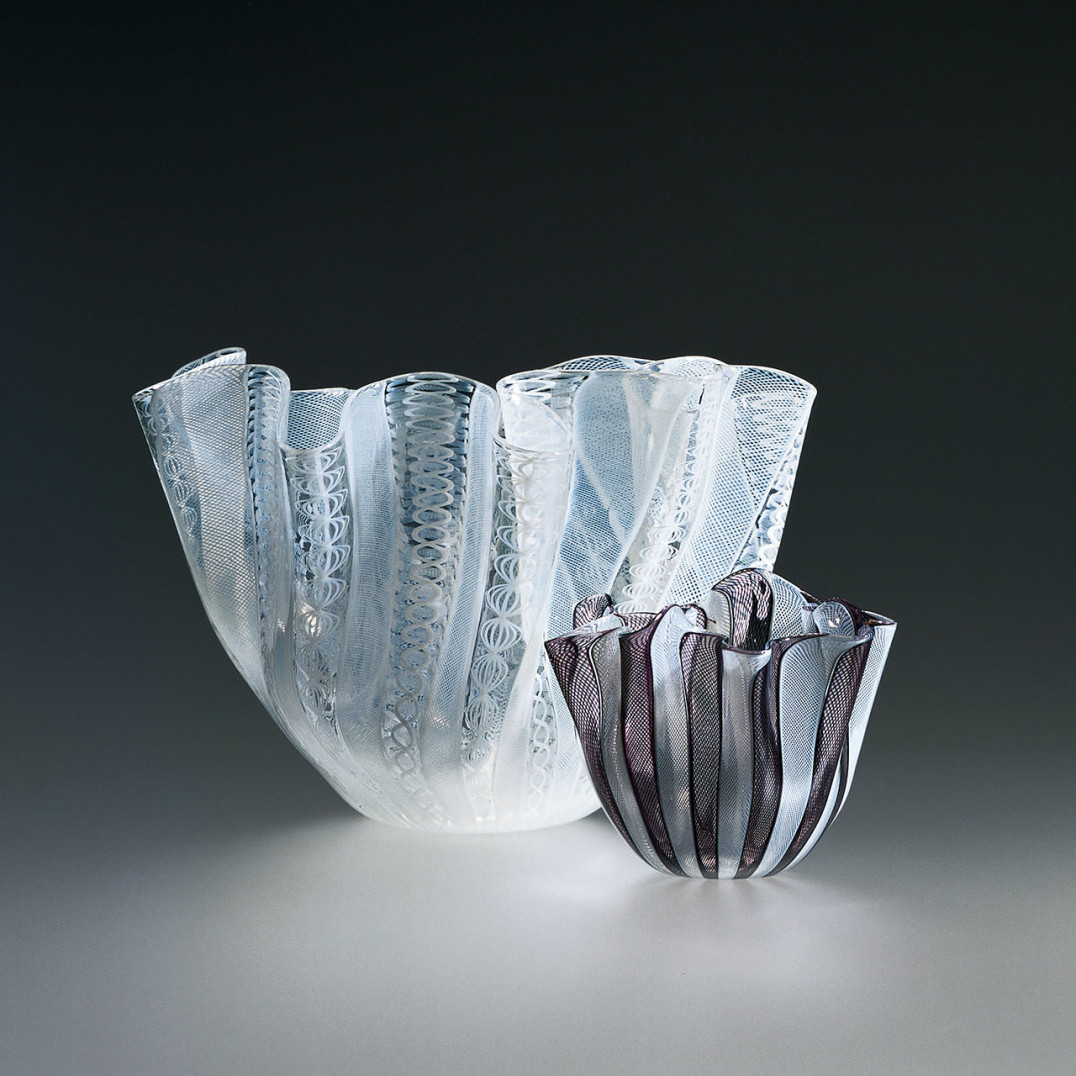
Fulvio BianconiPaolo VeniniFazzoletto, ca. 1950
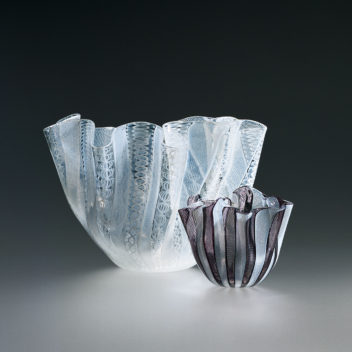
Fulvio BianconiPaolo VeniniFazzolettoVenini & C., ca. 1950
A handkerchief shaped vessel crafted with zanfirico lattimo canes of glass.
Acid stamped:
venini murano ITALIA.
11 1/4 in. high (28.6 cm)
Exhibitions:
1952, Venice, 26th Biennale Internazionale d’Arte;
2000, New York, Venetian Glass, Museum of Arts & Design;
2001, Milan, Murano: Vetri dalla Collezione Olnick Spanu, Spazio Oberdan.
Bibliography and comparative texts:
Venini, grey catalogue, nn. 4217, 1158;
Domus, October, 1951, p. 29;
R. Aloi, 1952, n. 29;
G. Ponti, 1959, p. 38;
Mille anni…, 1982, n. 649;
R. Barovier Mentasti, 1982, n. 323;
W. Neuwirth, 1987, n. 75;
R. Bossaglia, 1993, nn. 17, 20;
M. Barovier, 1994, nn. 14, 15;
F. Deboni, 1996, nn. 206, 207;
A. Venini Diaz de Santillana, 1996, nn. 130, 132; M. Heiremans, 1996, n. 84; H. Ricke, E. Schmitt, 1996, n. 69; M. Barovier, 1998 (b), p. 231;
Venini Venezia, 1998, p. 68;
M. Barovier, 1999, p. 231;
Olnick Spanu, 2000, n. 82;
Olnick Spanu, 2001, n. 116.

Fulvio Bianconi 1915–1996
Fulvio Bianconi was a graphic artist, caricaturist, and designer. Born in Padua, he attended the Istituto d'Arte and the Accademia di Belle Arti in Venice. He first encountered glass at age fifteen when he studied decoration with enamels under the guidance of Michele Pinto. During the late '30s, he worked as a caricaturist, graphic artist, and illustrator for various publishing houses such as Mondadori, Rizzoli, Garzanti, and others. After World War II, he came to Murano to study glass techniques and met Paolo Venini. A productive relationship ensued as he began a collaboration with Venini in 1947 that lasted through the entire decade of the '50s. One of his most characteristic works is the long series of stylized figurines which Bianconi designed at the end of the '40s, taking his inspiration from the Italian Commedia dell'Arte. His pezzati vessels proved extraordinary due to their richness in color, as were the fazzoletti, presented in several different vitreous textures, which he created with Venini himself. He obtained widespread acclaim for the a Macchie and Fasce orrizontali series, in which Bianconi revealed a marked painterly vocation. In the '50s, he worked with other workshops such as the Vetreria Cenedese, designing vessels with applications and other pieces with cased decorations. From 1958 to 1961, he designed glass pieces for I.V.R. Mazzega. In 1963, he designed for the Vetreria Vistosi. And in 1967, he began working again with Venini, creating vessels with unusual shapes such as the Informale (1968). After another contact with Venini in 1989, he designed for De Majo from 1991 to 1992.

Paolo Venini 1895–1959
Born in Milan, the entrepreneur and designer Paolo Venini was a law school graduate. From 1921 until he died, he dedicated himself to the workshop he founded, the Vetri Soffiati Muranesi Venini & C. (through 1925, Vetri Soffiati Muranesi Cappellin Venini & C.). A man of marked entrepreneurial talent, his goal from the very beginning was to expand his company's influence abroad and he sought the collaboration of the most talented artists and architects of his time, employing them as artistic directors of his company. He always worked at the side of his designers with the goal of anticipating and directing taste. He personally checked every collection produced by his furnace. And his confident aesthetic choices, along with the fine quality of the products, assured his workshop both critical and commercial success. He dedicated himself personally to design from the '30s: his Diamante glass pieces date from 1936, and he created the murrine romane in collaboration with Carlo Scarpa. Following the war, he created bottles with brightly colored stripes, vessels in mosaico zanfirico and mosaico tessuto, glass mosaic windows, and engraved vessels. In collaboration with Bianconi, he created vessels such as the fazzoletti, which are a classic example of the production of the '50s, and were enormously successful.

Venini & C. 1932–2001
In 1932, when both Martinuzzi and Zecchin left the company, Paolo Venini changed the name from Vetri Soffiati Muranesi Venini & Co. (V.S.M. Venini & Co.) to Venini & C.. Milanese architect Tommaso Buzzi became the new artistic director. After 1934, artistic direction was taken on by Carlo Scarpa, who designed most of the company's production through 1947. Side by side with Venini, who often intervened personally in design, Scarpa created numerous collections of objects characterized by refined colors. After World War II, Venini & C. sought numerous collaborations with artists such as architect Giò Ponti and the Swedish-born Tyra Lundgren. After 1948, Fulvio Bianconi, Massimo Vignelli, and Tobia Scarpa contributed significantly to the new direction of the company. Paolo Venini died in 1959 and his son-in-law, Ludovico Diaz de Santillana, took over the management of Venini & C. He not only worked personally as a glass designer but also continued the collaboration started by Paolo Venini with various artists and designers. Starting in 1960, many other designers collaborated with the company, like Thomas Stearns, Toni Zuccheri, Tapio Wirkkala, Laura and Alessandro Diaz de Santillana, James Carpenter, Dan Dailey, Richard Marquis, Benjamin Moore, and Toots Zynsky. In 1986, the de Santillana family left the company, selling their stock to the Ferruzzi group, which guaranteed the fine quality Venini was known for by hiring new designers such as Timo Sarpaneva, Marco Zanini, Ettore Sottsass Jr., Alessandro Mendini, Mario Bellini, Barbara del Vicario, and others. In 1988, Venini was acquired by Royal Scandinavian. Since 2001, Venini S.p.A. has been part of Italian Luxury Industries Group and is led by Giancarlo Chimento, Giuliano Tabacchi, and Giorgio Rizzo.